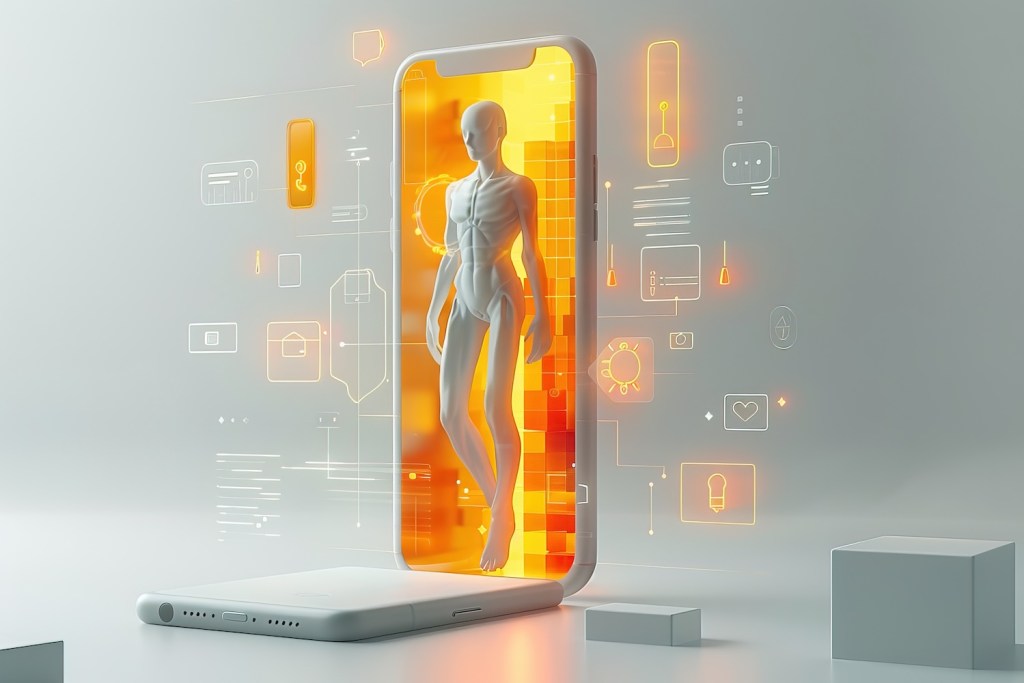Updated: Oct 02, 2024 By: Marios

Introduction
The healthcare industry has been experiencing a significant transformation with the advent of artificial intelligence (AI). AI has the potential to revolutionize the way we approach health, from diagnostics to treatment, offering more precise, personalized, and efficient solutions.
Health apps powered by AI are at the forefront of this change, providing innovative ways to enhance patient care, streamline medical processes, and improve overall outcomes. These apps are particularly beneficial in areas such as mental health, diagnostics, medical imaging, and drug discovery, making healthcare more accessible and effective.
In this blog post, we will explore seven of the top AI health apps in 2024, each playing a unique role in shaping the future of healthcare. We will discuss how these apps are being used to tackle real-world healthcare challenges and why they are considered game-changers in the industry.
Each of these apps leverages the power of AI in unique ways, from mental health support to medical imaging and drug discovery, demonstrating how AI is transforming healthcare at every level.
1. Youper: AI for Mental Health
Mental health is an area where AI is proving to be especially transformative, and Youper is a standout app in this field. Designed to provide mental health support and therapy through AI-driven interactions, Youper is an emotional health assistant that helps users manage their emotional well-being by providing personalized conversations, mindfulness exercises, and mental health insights.
How Youper Works
Youper uses natural language processing (NLP) and machine learning algorithms to engage users in real-time conversations, simulating the experience of speaking to a therapist. The app can assess a user's emotional state by analyzing their inputs and offering tailored guidance, whether it's practicing mindfulness, engaging in cognitive-behavioral therapy (CBT) techniques, or simply encouraging users to express their emotions.
Youper also allows users to track their moods over time, providing them with a visual representation of their emotional patterns. This feature helps users identify triggers for their emotions and monitor the effectiveness of the strategies they employ to manage stress and anxiety.
Benefits
- Accessibility: Youper makes mental health support available 24/7, providing immediate help to users in moments of need.
- Personalization: The app adapts to each user’s unique mental health journey, offering customized suggestions and exercises.
- Affordability: Compared to traditional therapy, Youper offers a more affordable solution, making mental health care accessible to a wider audience.
With the growing need for mental health support, Youper is revolutionizing how individuals approach their emotional well-being, providing an innovative, AI-driven solution that complements traditional therapy methods.
2. Binah.ai: AI for Health Monitoring
Binah.ai is an innovative app that leverages AI to provide comprehensive health monitoring using a smartphone camera. This app represents a leap forward in telemedicine, enabling users to track vital signs like heart rate, oxygen saturation, and stress levels without the need for specialized equipment.
How Binah.ai Works
Binah.ai utilizes video-based technology combined with AI algorithms to analyze subtle changes in facial skin color, which correspond to vital signs like heart rate, blood pressure, and oxygen saturation. By simply looking into their phone’s camera, users can receive real-time health metrics in a matter of seconds.
The app is designed to integrate with various health and fitness platforms, providing users with insights into their overall health. It also helps healthcare providers remotely monitor patients, improving care for those with chronic conditions or who require consistent health monitoring.
Benefits
- Convenience: Users can track their vital signs anytime, anywhere, without needing extra equipment or a visit to a healthcare facility.
- Telemedicine Integration: Binah.ai supports remote health monitoring, making it ideal for healthcare providers managing patients at a distance.
- Preventive Health: By allowing users to monitor their health in real-time, Binah.ai encourages preventive care, helping users detect early signs of potential health issues.
Binah.ai is a prime example of how AI is making healthcare more accessible and efficient, empowering users to take control of their health from the comfort of their homes.
3. Butterfly Network: AI-Powered Medical Imaging
Butterfly Network has revolutionized the world of medical imaging with its AI-powered, handheld ultrasound device, Butterfly iQ. This device is transforming diagnostics by making ultrasound technology more accessible to healthcare professionals across the globe.
How Butterfly Network Works
Butterfly Network’s device is an AI-enabled handheld ultrasound system that connects to a smartphone or tablet, allowing healthcare providers to conduct imaging in any setting. The AI within the system helps interpret the images in real-time, providing insights and identifying potential issues that the practitioner may need to investigate further.
The portable nature of the Butterfly iQ makes it a game-changer, especially in underserved areas where traditional ultrasound machines are not readily available. The app that accompanies the device allows for secure image storage and sharing, enabling healthcare professionals to collaborate remotely on diagnostics and treatment plans.
Benefits
- Portability: The handheld nature of the Butterfly iQ allows for on-the-go diagnostics, making it ideal for fieldwork and remote care.
- Affordability: Compared to traditional ultrasound machines, Butterfly Network’s device is much more affordable, making high-quality imaging accessible to more healthcare providers.
- AI Assistance: The AI integration assists clinicians in interpreting images, reducing the margin for error and improving diagnostic accuracy.
By democratizing access to medical imaging, Butterfly Network is helping to improve patient outcomes by making diagnostics faster, more affordable, and accessible to all.
4. Aidoc: AI for Medical Imaging and Diagnostics
Aidoc is an AI-powered platform designed to support radiologists in the interpretation of medical images. Aidoc uses advanced AI algorithms to analyze medical images such as CT scans, MRIs, and X-rays, identifying abnormalities and assisting healthcare professionals in making faster, more accurate diagnoses.
How Aidoc Works
Aidoc integrates directly into the radiology workflow, automatically analyzing images and flagging potential areas of concern for further review. The AI is trained to recognize a wide range of conditions, including brain hemorrhages, pulmonary embolisms, and spine fractures, among others. The platform continuously learns and improves its accuracy over time, ensuring that radiologists receive the most accurate insights possible.
The platform operates seamlessly with existing radiology systems, allowing it to fit into the daily routines of healthcare providers without causing disruption. Aidoc’s AI-driven approach significantly speeds up the diagnostic process, helping radiologists handle more cases with improved precision.
Benefits
- Efficiency: Aidoc reduces the time it takes to analyze medical images, allowing radiologists to focus on more complex cases.
- Accuracy: The AI's ability to detect abnormalities ensures that fewer diagnostic errors are made, leading to better patient outcomes.
- Scalability: Aidoc’s platform can analyze large volumes of medical images, making it ideal for high-demand environments like emergency rooms and large hospitals.
Aidoc’s integration of AI in medical imaging is a significant leap forward in diagnostics, offering healthcare providers the tools to deliver faster, more accurate care.
5. Tempus: AI for Precision Medicine
Tempus is at the forefront of precision medicine, using AI to analyze large datasets of clinical and molecular data to provide personalized treatment recommendations for cancer patients. Tempus combines AI with genomic sequencing, clinical data, and real-world evidence to help doctors make data-driven decisions about patient care.
How Tempus Works
Tempus collects and analyzes vast amounts of data from cancer patients, including genetic sequencing data and clinical records. The AI algorithms then identify patterns and correlations within the data that can inform treatment options. For example, Tempus can recommend targeted therapies based on a patient’s unique genetic makeup or predict how a patient may respond to a particular treatment.
The platform also allows oncologists to search for clinical trials that match a patient’s specific genetic profile, offering access to cutting-edge treatments that may not otherwise be available.
Benefits
- Personalized Care: Tempus provides tailored treatment recommendations based on the individual characteristics of each patient.
- Data-Driven Insights: By leveraging large datasets, Tempus helps oncologists make more informed decisions about treatment plans.
- Access to Clinical Trials: Tempus’ platform connects patients with clinical trials, offering them new avenues for treatment.
Tempus is transforming cancer care by empowering doctors with AI-driven insights, enabling them to provide personalized and precise treatments that improve patient outcomes.
6. Owkin: AI for Drug Discovery and Medical Research
Owkin is leveraging AI to accelerate drug discovery and medical research. The platform focuses on using machine learning to analyze biomedical data, helping researchers identify new drug targets and optimize clinical trials.
How Owkin Works
Owkin’s AI platform analyzes a range of biomedical data, including imaging, genetic, and clinical data, to identify patterns that could lead to new therapeutic discoveries. The platform uses federated learning, which allows it to analyze data from multiple sources without requiring the data to be centralized. This ensures privacy and security while enabling collaborative research across institutions.
Owkin’s AI models help researchers predict patient outcomes, identify biomarkers, and optimize clinical trial design.
By reducing the time and cost of drug discovery, Owkin is helping to bring new treatments to market faster.
Benefits
- Accelerated Drug Discovery: Owkin’s AI algorithms help identify potential drug candidates more quickly, reducing the time it takes to develop new treatments.
- Collaborative Research: The platform enables researchers to collaborate across institutions without compromising data privacy, facilitating more effective research.
- Improved Clinical Trials: Owkin optimizes the design of clinical trials, increasing the likelihood of success and reducing costs.
Owkin is at the cutting edge of AI in healthcare, driving innovation in drug discovery and making it easier for researchers to develop life-saving treatments.
7. PathAI: AI for Pathology
PathAI is an AI-powered platform designed to assist pathologists in diagnosing diseases, particularly cancer. The platform uses machine learning algorithms to analyze tissue samples and provide insights that help pathologists make more accurate diagnoses.
How PathAI Works
PathAI’s platform analyzes pathology slides, identifying patterns that indicate the presence of diseases such as cancer. The AI algorithms are trained on large datasets of pathology images, allowing the system to learn how to recognize abnormalities with high accuracy. Pathologists can use PathAI’s insights to confirm their diagnoses and make treatment recommendations with greater confidence.
The platform is also used in drug development, helping pharmaceutical companies identify biomarkers and assess the effectiveness of new treatments.
Benefits
- Improved Diagnostic Accuracy: PathAI’s algorithms help pathologists identify diseases more accurately, reducing the likelihood of diagnostic errors.
- Efficiency: The platform speeds up the diagnostic process, allowing pathologists to analyze more cases in less time.
- Drug Development Support: PathAI assists in identifying biomarkers, helping pharmaceutical companies develop more targeted therapies.
PathAI is transforming the field of pathology, offering pathologists and researchers a powerful tool to improve diagnostic accuracy and support the development of new treatments.
Conclusion
The integration of artificial intelligence in healthcare is opening up new possibilities for improving patient outcomes, enhancing the efficiency of medical processes, and making healthcare more accessible. From mental health support to diagnostics, drug discovery, and precision medicine, AI-powered health apps like Youper, Binah.ai, Butterfly Network, Aidoc, Tempus, Owkin, and PathAI are revolutionizing the way healthcare is delivered.
These apps represent the future of healthcare, where AI will play an increasingly central role in diagnosing diseases, managing patient care, and developing new treatments. As these technologies continue to evolve, we can expect even greater innovations that will further improve the quality and accessibility of healthcare around the world.
By embracing AI-driven solutions, healthcare professionals can provide better, more personalized care, ultimately leading to improved patient outcomes and a more efficient healthcare system. The future of healthcare is undoubtedly being shaped by AI, and the apps we’ve discussed are just the beginning of this exciting transformation.


